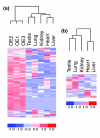Characterizing the expression of the human olfactory receptor gene family using a novel DNA microarray
- PMID: 17509148
- PMCID: PMC1929152
- DOI: 10.1186/gb-2007-8-5-r86
Characterizing the expression of the human olfactory receptor gene family using a novel DNA microarray
Abstract
Background: Olfactory receptor (OR) genes were discovered more than a decade ago, when Buck and Axel observed that, in rats, certain G-protein coupled receptors are expressed exclusively in the olfactory epithelium. Subsequently, protein sequence similarity was used to identify entire OR gene repertoires of a number of mammalian species, but only in mouse were these predictions followed up by expression studies in olfactory epithelium. To rectify this, we have developed a DNA microarray that contains probes for most predicted human OR loci and used that array to examine OR gene expression profiles in olfactory epithelium tissues from three individuals.
Results: We detected expression of 437 (76%) human OR genes in these olfactory epithelia. Interestingly, we detected widespread expression of OR pseudogenes, an observation that may shed light on the mechanism of OR gene choice in the olfactory sensory neurons. To address the hypothesis that OR genes may carry out additional functions, we also characterized the expression of OR genes in a number of non-olfactory tissues.
Conclusion: While our results corroborate the functional annotation of the majority of predicted human odorant receptors, we find that a large number of putative human OR genes are expressed in non-olfactory tissues, sometimes exclusively so. Our evolutionary analysis of ectopically expressed human OR genes does not lend support to the hypothesis that these genes have alternative functions.
Figures



Similar articles
-
A signature of evolutionary constraint on a subset of ectopically expressed olfactory receptor genes.Mol Biol Evol. 2009 Mar;26(3):491-4. doi: 10.1093/molbev/msn294. Epub 2008 Dec 22. Mol Biol Evol. 2009. PMID: 19103638 Free PMC article.
-
The human olfactory transcriptome.BMC Genomics. 2016 Aug 11;17(1):619. doi: 10.1186/s12864-016-2960-3. BMC Genomics. 2016. PMID: 27515280 Free PMC article.
-
Odorant receptor expressed sequence tags demonstrate olfactory expression of over 400 genes, extensive alternate splicing and unequal expression levels.Genome Biol. 2003;4(11):R71. doi: 10.1186/gb-2003-4-11-r71. Epub 2003 Oct 7. Genome Biol. 2003. PMID: 14611657 Free PMC article.
-
Odorant Receptors.In: Menini A, editor. The Neurobiology of Olfaction. Boca Raton (FL): CRC Press/Taylor & Francis; 2010. Chapter 7. In: Menini A, editor. The Neurobiology of Olfaction. Boca Raton (FL): CRC Press/Taylor & Francis; 2010. Chapter 7. PMID: 21882436 Free Books & Documents. Review.
-
Molecular biology of odorant receptors in vertebrates.Annu Rev Neurosci. 1999;22:487-509. doi: 10.1146/annurev.neuro.22.1.487. Annu Rev Neurosci. 1999. PMID: 10202546 Review.
Cited by
-
Led by the nose: Olfaction in primate feeding ecology.Evol Anthropol. 2015 Jul-Aug;24(4):137-48. doi: 10.1002/evan.21458. Evol Anthropol. 2015. PMID: 26267435 Free PMC article.
-
Olfactory receptor coding sequences cause silencing of episomal constructs in multiple cell lines.Mol Cell Neurosci. 2021 Dec;117:103681. doi: 10.1016/j.mcn.2021.103681. Epub 2021 Nov 4. Mol Cell Neurosci. 2021. PMID: 34742908 Free PMC article.
-
A signature of evolutionary constraint on a subset of ectopically expressed olfactory receptor genes.Mol Biol Evol. 2009 Mar;26(3):491-4. doi: 10.1093/molbev/msn294. Epub 2008 Dec 22. Mol Biol Evol. 2009. PMID: 19103638 Free PMC article.
-
Odorant Receptors Containing Conserved Amino Acid Sequences in Transmembrane Domain 7 Display Distinct Expression Patterns in Mammalian Tissues.Mol Cells. 2017 Dec 31;40(12):954-965. doi: 10.14348/molcells.2017.0223. Epub 2017 Nov 23. Mol Cells. 2017. PMID: 29179263 Free PMC article.
-
System-Wide Expression and Function of Olfactory Receptors in Mammals.Genomics Inform. 2018 Mar;16(1):2-9. doi: 10.5808/GI.2018.16.1.2. Epub 2018 Mar 30. Genomics Inform. 2018. PMID: 29618184 Free PMC article. Review.
References
MeSH terms
Substances
Associated data
- Actions
Grants and funding
LinkOut - more resources
Full Text Sources
Other Literature Sources
Molecular Biology Databases

